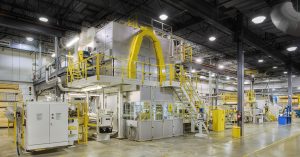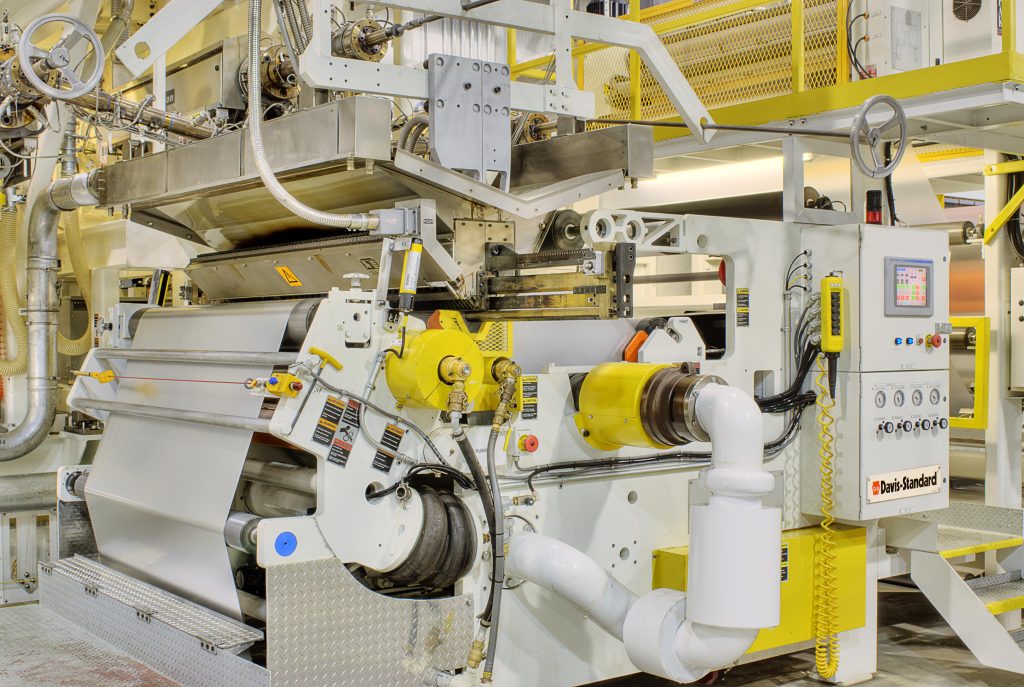Both extrusion coating and adhesive lamination can be used to manufacture a flexible packaging...
Extrusion Coating Pros for Adhesive Lamination Structures

In this blog, we’ll discuss how extrusion coating offers several advantages in terms of output, cost-effectiveness and performance when compared to adhesive lamination. We’ll cover factors that influence the switch to extrusion coating as well as typical product structures.
Extrusion Coating Advantages
Environment – In extrusion coating, fewer non-plastic components go into the recycling process. An adhesive laminated chip bag is 15.6 percent non-plastic, whereas an extrusion coated chip bag is 2.5 percent non-plastic.
Space and Output – Extrusion coating can offer savings in terms of space and output. Adhesive laminators and extrusion coating lines typically operate at speeds of 1,000 to 1,500 feet per minute. But, an adhesive laminator requires a much longer footprint to achieve that same speed. Where a primer dryer on an extrusion coating line requires about 20 feet of effective drying at 1,500 feet per minute, an adhesive laminator at the same speed may need a 100-foot multi-zone dryer.
White Background – To make graphics pop, a white background is often needed in packaging graphics. The extrusion coating process can make this 5 to 10 percent less expensive when you compare the cost of a masterbatch to applying a flood white coat at your printer. Additionally, you need a smaller dryer (fewer solvents to dry) and better press stability. You can also reduce pin-holing and improve opacity.
Pellets to Product – To add film weight through adhesive lamination, you need to buy thicker film(s) to laminate. In extrusion coating, you can simply down-gauge the film and increase the extrudate thickness.
Multi Structure Efficiency – In adhesive lamination, if you run a similar structure but at different thicknesses, you must introduce and stock different thickness substrates. In extrusion coating, you can simply add extrudate thickness stocking the same substrate.
Stronger Seal Bond – Since adhesive lamination involves a thin adhesive laminating two films, stresses can occur to the package’s fin seal during filling After the package is released from the clamps, the material will try to revert back to their original position before the clamp, causing a void in the package. Extrusion coating applies a thicker and softer process whereby the softness helps reduce this effect
Finally, as you evaluate whether or not to make the switch, consider the following:
-
- Resins needed to address the same specifications required by your adhesive lamination structures. Davis-Standard can help you determine how.
- Space and output requirements; extrusion coating can achieve higher outputs with a smaller footprint.
- Cost considerations relative to scrap, pellets-to-product savings, stock efficiency.
- Options for modifying existing adhesive lamination lines to make the move to extrusion coating less costly.
Have questions or comment about this blog? Comment below, we’d love to hear from you!
Have an emergency? Don’t hesitate to contact our service team at (844 MYDAVIS). For any other questions, e-mail marketing at marketing@davis-standard.com.
Stay safe and healthy!


